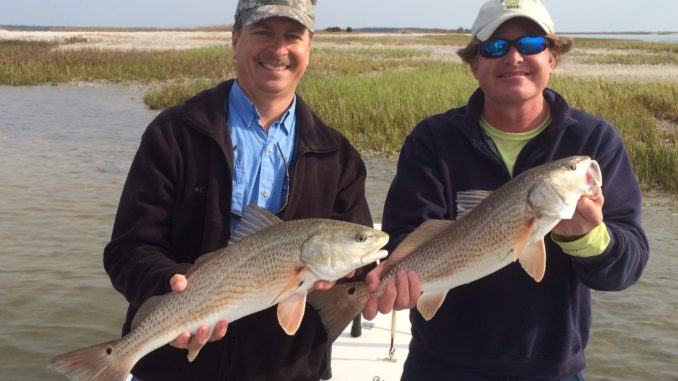
Look for clear water between full and new moons for best fishing.
Warmer weather has brought redfish out of their winter posture and into a feeding mode along the Santee Delta, but you’d better check the moon phase and water clarity, because it can determine whether a trip is a banner day or an epic fail. Right now, Capt. Jordan Pate of Carolina Guide Service is smacking the redfish under the right conditions.
“The delta has been very good to me and my clients lately. Redfish have been very cooperative on favorable moon phases,” said Pate (843-608-8307). “Throw in the combination of little tide movement and warm, sunny skies, you can really put a redfish beatdown.”
Moon phases controls the tides and, more importantly, the strength of the tide. On strong tides around a full or new moon, the pluff mud-covered flats around the coastal region will pick up suspended sediments and flush them into the bays and creeks.
“The water around WinyahBay, Santee Delta, and Cape Romain are particularly vulnerable to less-than-ideal water clarity. Big tides turn the bottom up; throw in all the rain, and things can get real ugly,” he says.
Pate prefers to fish around the first- or second-quarter moon phases for the best chance at clear water.
As the waters warm, redfish are looking for quick meals to fuel their metabolisms, and according to Pate, small shrimp are beginning to show up in redfish territory, firing up the reds to another level.
“Despite all the cool weather, we’re already starting to see a strong grass shrimp hatch in the creeks that is the perfect opportunity to start using small shrimp imitations again,” he said.
Redfish, trout, black drum and every other fish in the ocean will feast on shrimp at any and every opportunity. Pate is using the small Vudu Shrimp mostly, but he is still having regular success on weedless jerkbaits.
“Artificial baits are working great right now, but the springtime grass that covers the bottom can be really frustrating,” he said. “Going weedless or using suspending baits are about the only ways to create a realistic presentation.”
Pate is having his best success around shell islands and along the edges of grassy bays from the middle of the tide down. As the water leaves the grass flats, the current carries plenty of food out into deeper water where reds will be waiting in ambush.
On the live bait side, mud minnows fished under a popping cork or fished on a small jighead have been productive.




Be the first to comment